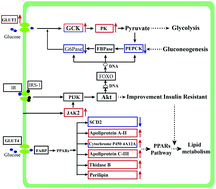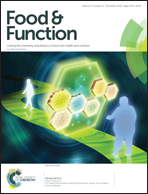Hypoglycemic mechanisms of Ganoderma lucidum polysaccharides F31 in db/db mice via RNA-seq and iTRAQ†
Abstract
Our team has previously demonstrated that Ganoderma lucidum polysaccharides F31 have hypoglycemic effects on diabetic mice. This study provides insight into the system-level hypoglycemic mechanisms of F31 by the integrative analysis of transcriptomics and proteomics data. To explore the omics perspective for the mechanisms of action, the protein and gene expression in the liver from the normal control (NC), diabetic db/db control mice (DC) and F31-treated db/db mice (F31) were analyzed by iTRAQ and RNA-Seq. The differential expression proteins (DEPs) and differential expression genes (DEGs) were analyzed based on their gene ontology (GO) annotations and the Kyoto Encyclopedia of Genes and Genomes (KEGG) pathway enrichment, and the expression of DEGs and DEPs was verified by quantitative polymerase chain reaction (qPCR) and western blotting (WB). We identified sixty-five DEGs and sixty-two DEPs in the F31-treated group as compared with the DC. Integrated analysis of the RNA-Seq data and proteomics data indicated that the two DEGs/DEPs—Gck [glucokinase (GCK)] and Cyp4a12a [cytochrome P450, family 4, subfamily a, polypeptide 12a (CYP4A12A)]—showed the same trend in mRNA and protein expression levels in the comparison of F31-VS-DC. KEGG analysis revealed that the peroxisome proliferator-activated receptors (PPARs) signaling pathway was enriched in both of the comparisons of NC-VS-DC and F31-VS-DC at the protein expression level. In the analysis of the gene and protein expression of candidate proteins targeting diabetes, we found that three genes [Gck, glucose-6-phosphatase (G6Pase), phosphoenolpyruvate carboxykinase (PEPCK)] and three proteins [GCK, glucose transporter type 2 (GLUT2), pyruvate kinase (PYK) ] in the glycolysis and gluconeogenesis pathways, proteins of the Janus-activated kinase 2 (JAK2) in the insulin pathway, and two genes [Cyp4a12a and stearoyl-CoA desaturase 2 (SCD2)] in the lipid metabolism were expressed significantly differently in the F31-treated group as compared with the DC group, which played important roles in the hypoglycemic activity of F31. Cluster analysis demonstrated that microRNAs probably participated in the regulation of the genes involved the glucose metabolism. These results provide theoretical evidence for F31 as a potential functional food ingredient for the prevention and treatment of type 2 diabetes.



 Please wait while we load your content...
Please wait while we load your content...